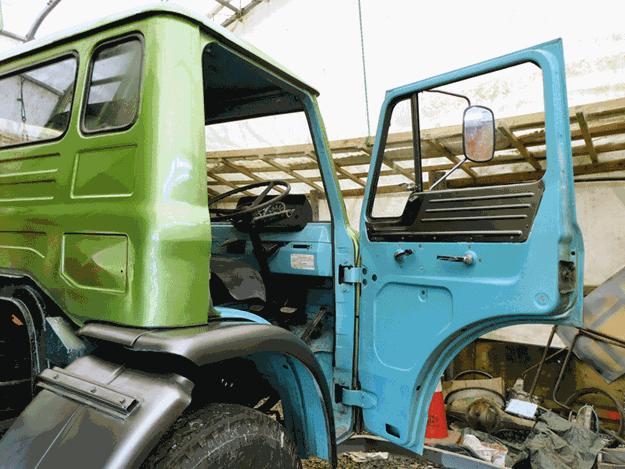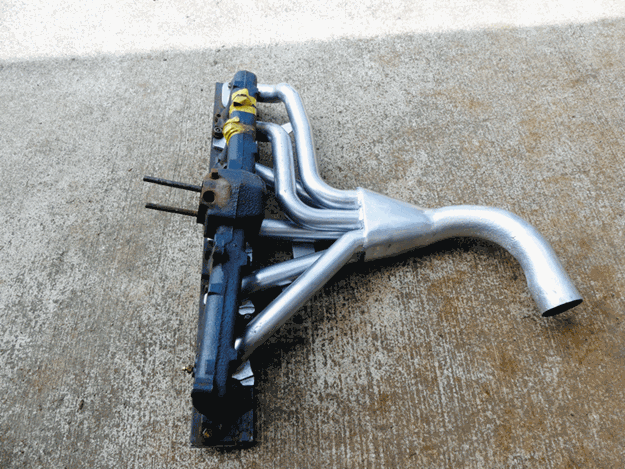Restoration: D750 Ford—Part 28
With signwriting and fleet number decisions to be made soon, is the Ford D750 restoration nearing its end?
 |
|
The cab repainted—one more job crossed off the list
|
After several months of feeling embarrassed about having to tell yet another sad story of a lack of progress, we’ve now reached a stage where there’s actually some light at the end of the tunnel, where it’s not just some bugger carrying a torch with a whole lot more work to perform.
Re-reading last month’s instalment, I see that I said that you can kick my backside if I haven’t got a final coat of paint on the cab. So I’m pleased to report that there’ll be no need for this old restorer to insert a book in his pants in order to alleviate the shock from a planted boot.
On 23 October, the day dawned bright and fine, which was perfect for painting. I’d spent several days prepping the cab and had been waiting for the right time to apply the final coat.
The ‘right time’, I might add, wasn’t just about the weather conditions being right, as I also had to gird my loins by having my head in the right space before carrying out the task.
I’ve found from bitter experience that applying the final coat of paint on a vehicle (for me anyway) is quite unlike any other part of the restoration process. What I’m saying is that if you cut a bit of panel steel a bit short or if your weld isn’t too flash, you can always go back and redo the work without stuffing things up too badly.
Even if you get a run in the primer coat, you can sand it out, give the patch a respray, and carry on without affecting the final outcome. But I have to say that applying the finish coat half scares me to death, with it all being made worse by the fact that even if you manage to do a reasonable job of applying the base coat, the fear factor has to be overcome a second time round when it comes to doing the clear coat.
I know a lot of you will be saying if painting scares me so much, why doesn’t the silly old fool find a professional to do the job for him? I guess the answer would have to be that the silly old fool in question wouldn’t ever learn any new tricks if he did that, besides which, he’s way too mean to pay somebody else to have all the fun.
There are some things, however, that have to be left to the professionals, such as signwriting. Just to prove that we’re really cracking on with the restoration, I’ve called in Keith Ellis who’s done all of the signwriting work on my previous trucks.
On my first restoration, the K Bedford, fleet No 14, Keith did the signwriting the traditional way. Because of the age of the truck (1953), we felt it was more appropriate that it was handwritten, even though you have to look pretty hard to see the difference between the traditional method and applying vinyl lettering.
Even after accounting for the fact that hand-writing with drop-shading is a lot more expensive, I figured that the ‘K’ deserved an age-appropriate style of lettering to finish the project off.
 |
|
Door trim in place for the last time
|
I applied the same logic when it came to placing the lettering on the doors of the 1964 FGK Morris tow wagon, fleet No 3, although, I did have to compromise by using vinyl for the ’24 Hour Towing’ sign on the chariot-style sides of the deck when the budget started to run low.
When it came to putting the signage on the 1991 Mitsubishi transporter that had received a mini-restoration in 2017, it was a no-brainer to go with vinyl because of the truck’s relatively young age and, of course, there was the money-saving factor to take into account.
I know it’s a bit borderline but with the D Series being a 1970 model, after a lot of humming and haring, I decided to do this one in vinyl as well, partially because of the money side of things but also to speed up what’s becoming a rather protracted restoration.
The ‘D’ is to be given fleet No 17 for reasons that are a bit too long-winded to explain in detail. To give a quick overview of my fleet numbering system, I have to be honest and say that it’s mostly happenstance, as the first restoration (the K Bedford) was given the No 14, as at the time I believed it was the 14th truck I’d ever owned when I bought it back in 1979.
Later research proved that it was actually the 15th, which threw any future numbering system out the window, so now I simply choose a number that looks good, and I go with that.
While I have Keith the signwriter on the job, he’s doing some signage on my little Daihatsu Delta and applying No 9 to its cab, making it look like I have a whole fleet of old stuff with fleet numbers 3, 9, 14, 17, and 18.
I’m still deciding which truck will be off the restoration rank, but whatever it is, at least I’ve already decided that it’ll be given fleet No 10. See, I can at least make some decisions easily.
Aside from getting the paint on the cab and organising the signwriting, we’ve had major movement on the exhaust manifold front, with my good old restoration mate Murray having completed a marathon effort in fabricating a new extractor unit to replace the previous unit that was beyond repair.
 |
|
My old mate Murray hard at work
|
Murray’s new creation, along with the original cast iron inlet manifold, which had a couple of pieces missing, is currently with Machine Part Welding in Penrose. They can repair the unit and surface both manifolds and have them back to me to fit to the truck in time for Part 29 next month.
 |
|
Just the faces to be surfaced and job done
|
Also, Colin Dunn at CRD Automotive in Avondale has found an internal leak in the brake booster, which he’s endeavouring to have repaired in a week or two provided he can source a couple of seals which are currently proving to be elusive. So, there we have it for this month. Here’s hoping that with this sudden rush of activity, we just may be near the end of the run.
Find new and used trucks for sale in NZ
Keep up to date in the industry by signing up to Deals on Wheels' free newsletter or liking us on Facebook.


.jpg)




.jpg)



.gif)
.jpg)
.jpg)
.jpg)
.jpg)

